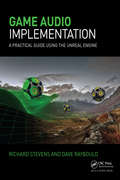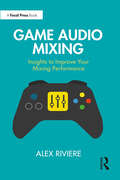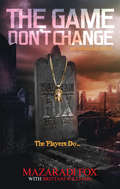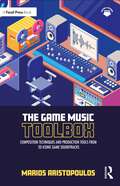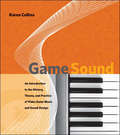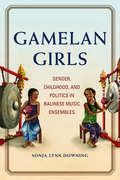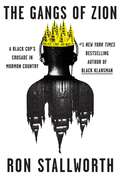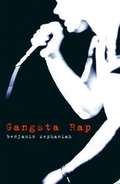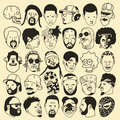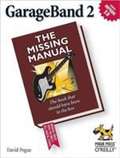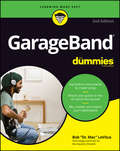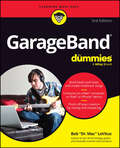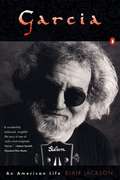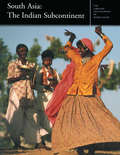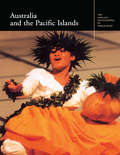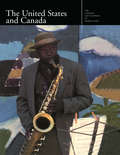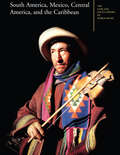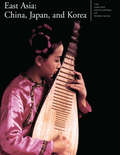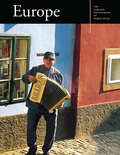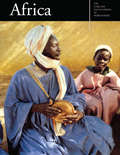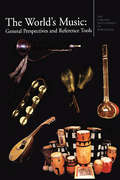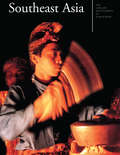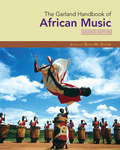- Table View
- List View
Game Audio Implementation: A Practical Guide Using the Unreal Engine
by Richard Stevens Dave RaybouldGame Audio Implementation offers a unique practical approach to learning all about game audio. If you've always wanted to hear your sound or music in a real game then this is the book for you. Each chapter is accompanied by its own game level where you can see the techniques and theories in action before working through over 70 exercises to develop your own demo level. Taking you all the way from first principles to complex interactive systems in the industry standard Unreal Engine© you’ll gain the skills to implement your sound and music along with a deep transferable knowledge of the principles you can apply across a range of other game development tools. <P><P> The accompanying website (www.gameaudioimplementation.com) includes: <P><P> <P><P>12 downloadable demonstration games <P><P>A unique exercise level for you to develop for your portfolio <P><P>An up-to-date online bibliography with further reading for each chapter <P><P>A free sound library with hundreds of game SFX
Game Audio Mixing: Insights to Improve Your Mixing Performance
by Alex RiviereGame Audio Mixing offers a holistic view of the mixing process for games, from philosophical and psychological considerations to the artistic considerations and technical processes behind acoustic rendering, interactive mixing, mastering, and much more. This book includes a comprehensive overview of many game audio mixing techniques, processes, and workflows, with advice from audio directors and sound supervisors. Through a series of accessible insights and interviews, the reader is guided through cutting-edge tips and tricks to equip them to improve their own mixing practice. As well as covering how to plan and create a mix that is clear, focused, and highly interactive, this book provides information about typical mixing tools and techniques, such as dealing with bus structure, frequency spectrum, effects, dynamic, volume, 2D and 3D spaces, and automations. Key information about how to deal with a large number of sounds and their prioritization in the mix is also included, from high-level mixing visions to in-depth designs with sound categorizations at the core. Game Audio Mixing is essential reading for all game audio professionals, including those new to the industry, as well as experienced professionals working on AAA and indie titles, in addition to aspiring professionals and hobbyists.
The Game Don't Change
by Mazaradi FoxThe posthumous novel from legendary Queens rapper Mazaradi Fox, who was once a member of 50 Cent's G-Unit crew. “A gripping, gritty, riveting read from cover to cover . . . Highly recommended.” —Midwest Book Review Mazaradi Fox wrote this novel in 2013 during his incarceration at the Orleans Correctional Facility. The Game Don’t Change opens when DeMarco Jones escapes from a juvenile detention center. Successfully evading the law, DeMarco builds his reputation on the streets of Queens as a fearless and charismatic drug hustler. Though he is only sixteen, women of all ages can’t get enough of him. He quickly finds, however, that he must battle ferociously to maintain his new kingpin status.
The Game Music Toolbox: Composition Techniques and Production Tools from 20 Iconic Game Soundtracks
by Marios AristopoulosThe Game Music Toolbox provides readers with the tools, models, and techniques to create and expand a compositional toolbox, through a collection of 20 iconic case studies taken from different eras of game music. Discover many of the composition and production techniques behind popular music themes from games such as Cyberpunk 2077, Mario Kart 8, The Legend of Zelda, Street Fighter II, Diablo, Shadow of the Tomb Raider, The Last of Us, and many others. The Game Music Toolbox features: Exclusive interviews from industry experts Transcriptions and harmonic analyses 101 music theory introductions for beginners Career development ideas and strategies Copyright and business fundamentals An introduction to audio implementation for composers Practical takeaway tasks to equip readers with techniques for their own game music The Game Music Toolbox is crucial reading for game music composers and audio professionals of all backgrounds, as well as undergraduates looking to forge a career in the video game industry.
Game Sound: An Introduction to the History, Theory, and Practice of Video Game Music and Sound Design (The\mit Press Ser.)
by Karen CollinsAn examination of the many complex aspects of game audio, from the perspectives of both sound design and music composition.A distinguishing feature of video games is their interactivity, and sound plays an important role in this: a player's actions can trigger dialogue, sound effects, ambient sound, and music. And yet game sound has been neglected in the growing literature on game studies. This book fills that gap, introducing readers to the many complex aspects of game audio, from its development in early games to theoretical discussions of immersion and realism. In Game Sound, Karen Collins draws on a range of sources—including composers, sound designers, voice-over actors and other industry professionals, Internet articles, fan sites, industry conferences, magazines, patent documents, and, of course, the games themselves—to offer a broad overview of the history, theory, and production practice of video game audio. Game Sound has two underlying themes: how and why games are different from or similar to film or other linear audiovisual media; and technology and the constraints it has placed on the production of game audio. Collins focuses first on the historical development of game audio, from penny arcades through the rise of home games and the recent rapid developments in the industry. She then examines the production process for a contemporary game at a large game company, discussing the roles of composers, sound designers, voice talent, and audio programmers; considers the growing presence of licensed intellectual property (particularly popular music and films) in games; and explores the function of audio in games in theoretical terms. Finally, she discusses the difficulties posed by nonlinearity and interactivity for the composer of game music.
Gamelan Girls: Gender, Childhood, and Politics in Balinese Music Ensembles (New Perspectives on Gender in Music)
by Sonja Lynn DowningIn recent years, girls' and mixed-gender ensembles have challenged the tradition of male-dominated gamelan performance. The change heralds a fundamental shift in how Balinese think about gender roles and the gender behavior taught in children's music education. It also makes visible a national reorganization of the arts taking place within debates over issues like women's rights and cultural preservation. Sonja Lynn Downing draws on over a decade of immersive ethnographic work to analyze the ways Balinese musical practices have influenced the processes behind these dramatic changes. As Downing shows, girls and young women assert their agency within the gamelan learning process to challenge entrenched notions of performance and gender. One dramatic result is the creation of new combinations of femininity, musicality, and Balinese identity that resist messages about gendered behavior from the Indonesian nation-state and beyond. Such experimentation expands the accepted gender aesthetics of gamelan performance but also sparks new understanding of the role children can and do play in ongoing debates about identity and power.
The Gangs of Zion: A Black Cop's Crusade in Mormon Country
by Ron StallworthNew York Times bestselling author of Black Klansman, Ron Stallworth, returns with another firsthand account of trailblazing police work in the most unlikely place for a Black cop in the &’90s. Determined to pursue his passion for undercover work wherever it leads, Ron Stallworth finally lands in Salt Lake City, Utah. Once again, he&’s an outsider—not only as a Black man on a mostly white police force but also as an unapologetic nonbeliever in a state dominated by the Church of Jesus Christ of Latter-Day Saints. But soon after his first drug bust in the Beehive, Stallworth makes a startling discovery—Bloods and Crips are infiltrating Mormon Country, threatening to turn the deeply conservative community into a hotbed of crime. Kids are bombing homes while carrying pocket versions of the Book of Mormon, yet his fellow cops are in denial that gangs are wreaking havoc in their Christian town. Now Stallworth has a new mission. Whether facing off with skinheads at a downtown bar or schooling white Crips blasting &“F*ck tha Police,&” he is intent on stemming the tide of gangs into the state. But those he expected to be his allies either have their heads in the sand or their own agendas—from the racist Mormon legislator to the community activist exploiting a fatal gang incident to spread paranoia over an imaginary race war. As he butts heads with these so-called leaders, Stallworth also realizes that gangsta rap has the key to the g-code. He becomes obsessed with—even defensive of—the music he once loathed and puts himself on the front lines of America&’s culture war. Now he&’s spitting uncensored lyrics before Congress and taking the stand in the 1993 murder case that puts hip-hop on trial. But the more Stallworth speaks truth to power, the more determined the gatekeepers in Utah are to silence him, and not even twenty-three years of police work could prepare him for how low they would stoop.
Gangsta Rap
by Benjamin ZephaniahSchool, what school? My name is X-Ray-X So be careful how you flex I used to freestyle in me bedroom. But me daddy got me vex. The teacher kicked me out of the classroom. Now I'm rapping in The Rex. Ray has trouble at home and trouble at school. It's the last straw for everyone when Ray and his friends Prem and Tyrone are permanently suspended. But they know what they want, more than most, perhaps. Their headmaster decides to give them a second chance, a chance to live their dream of forming a rap group. Through a specialized social program, the boys are taught the business of the music industry, what it takes to record an album, and how to lay down a track. Within weeks they have become the Positive Negatives, and within a few months they have signed a record deal and are on their way to the top. But their dream soon becomes a nightmare as violence escalates around them. Suddenly, not only their careers but their very lives are at stake. The Positive Negatives are determined to prove that you don't need to be a gangster to be a great rapper.
Gangster Doodles
by Marlon SassyA collectible, four-color illustrated A–Z treasury of gangster rappers, the hip-hop high-life, and notorious pop culture history, told through a series of graphic doodles on 3” x 3” sticky notes.Four years ago, a Post-it® note changed Marlon Sassy’s life. Using office supplies “borrowed” from his admin job, Sassy began creating colorful sketches of rappers in highlighter, Sharpie, and pen. He made his debut posting his rendition of Snoop on Tumblr under the pseudonym “Gangster Doodles.” Next was Bart Simpson and Biggie, then Yams and Yeezy. Soon, he had amassed a cult following of fans who clamored for his next artistic interpretation.Gangster Doodles brings together more than 400 of his most popular illustrations with thirty never-before-seen pieces. An impressive and comprehensive A–Z compendium, it features everyone from Black Jesus to Beyoncé, Kendrick Lamar to LeBron James, Jean-Michel Basquiat to Young Thug, and Kermit the Frog to Action Bronson. This is the ultimate gift for rap fanatics and pop culture addicts alike.
GarageBand 2: The Missing Manual
by David PogueWhether you're a professional musician or a mere novice, Apple's GarageBand software has everything you need to produce commercial-quality recordings entirely on your own. Just imagine how many thousands of singers and instrumentalists remain undiscovered because they lack the capability to produce viable demos. Well, no more. Now there's no need to assemble a backup band or book time at a professional studio--GarageBand has it covered. And GarageBand 2: The Missing Manual gives you the know-how you need to make it all happen. It's an authoritative, witty guide to constructing digital recordings with GarageBand. Written by the master of the Missing Manual series, and a musician himself, David Pogue, this top-selling book shows you how to maximize the program's entire set of tools. Pre-recorded loops, sampled sounds, live recordings--they're all explained in easy-to-understand language. It also shows you how to apply professional-sounding effects like reverb or chorusing, and then export the finished product to iTunes, where you can download your work to an iPod, export it as an MP3, or burn it onto CDs. Now revised to reflect GarageBand's latest features, this book's second edition also addresses how to: use GarageBand's eight-track capabilities display music notation in real time enhance timing and pitch for better quality recordings change the tempo and key of recorded instruments tune guitars with GarageBand before recording So if you're chasing a dream or just having fun, GarageBand 2: The Missing Manual is the only resource you need to make the finest musical recordings possible.
GarageBand 2: The Missing Manual
by David PogueWhether you're a professional musician or a mere novice, Apple's GarageBand software has everything you need to produce commercial-quality recordings entirely on your own. Just imagine how many thousands of singers and instrumentalists remain undiscovered because they lack the capability to produce viable demos. Well, no more. Now there's no need to assemble a backup band or book time at a professional studio--GarageBand has it covered. And GarageBand 2: The Missing Manual gives you the know-how you need to make it all happen. It's an authoritative, witty guide to constructing digital recordings with GarageBand. Written by the master of the Missing Manual series, and a musician himself, David Pogue, this top-selling book shows you how to maximize the program's entire set of tools. Pre-recorded loops, sampled sounds, live recordings--they're all explained in easy-to-understand language. It also shows you how to apply professional-sounding effects like reverb or chorusing, and then export the finished product to iTunes, where you can download your work to an iPod, export it as an MP3, or burn it onto CDs. Now revised to reflect GarageBand's latest features, this book's second edition also addresses how to: use GarageBand's eight-track capabilities display music notation in real time enhance timing and pitch for better quality recordings change the tempo and key of recorded instruments tune guitars with GarageBand before recording So if you're chasing a dream or just having fun, GarageBand 2: The Missing Manual is the only resource you need to make the finest musical recordings possible.
GarageBand For Dummies
by Bob LeVitusLay down some tracks—no garage required! GarageBand has become the default musical sketchpad for both well-known artists and hobbyists musicians who want a simple way to record, edit, and share their own tunes. GarageBand For Dummies is your go-to guide to navigating the interface and making the tweaks to create your own songs. Look inside to discover how to lay down a beat with the virtual drum kits, layer on sweet sounds with built-in virtual instruments, and attach simple hardware to record vocals or live instruments on a Mac, iPad, or even an iPhone. Use built-in instruments to create a song Attach your guitar or mic to record live sounds Export your final product or individual tracks Add effects and edit your song GarageBand is the simplest way to create basic tracks without investing in costly hardware and learning a complex digital audio workstation software package—and this book shows you how.
GarageBand For Dummies
by Bob LeVitusPut together great-sounding audio tracks on Mac, iPhone, or iPad GarageBand For Dummies gets you started with the popular audio software included with Apple devices. This simple app lets you do everything from building basic beats to creating multi-track recordings. You’ll learn how to build a song from the ground up in this beginner-friendly Dummies guide. Follow simple, step-by-step instructions that guide you through building percussion loops, adding melodies, and recording live vocals or other instruments. When your masterpiece is complete, this book shows you how to mix and master your tracks and get them ready to share with the world. You, GarageBand, and GarageBand For Dummies are about to make beautiful music together. Learn the GarageBand interface and set up recording sessions Set up your recording space to get the best quality audio from vocal and instrument sessions Add beats and loops or perform on built-in instruments Blend your tracks into a final mixFor easily creating recordings and demos using the free GarageBand app, this is the book you need.
Garcia: An American Life
by Blair JacksonHe was there when Dylan went electric, when a generation danced naked at Woodstock, and when Ken Kesey started experimenting with acid. Jerry Garcia was one of the most gifted musicians of all time, and he was a member of one of the most worshiped rock 'n' roll bands in history. Now, Blair Jackson, who covered the Grateful Dead for twenty-five years, gives us an unparalleled portrait of Garcia--the musical genius, the brilliant songwriter, and ultimately, the tortured soul plagued by his own addiction. With more than forty photographs, many of them previously unpublished, Garcia: An American Life is the ultimate tribute to the man who, Bob Dylan said, "had no equal."
The Garland Encyclopedia of World Music: South Asia: The Indian Subcontinent (Garland Encyclopedia of World Music #Vol. 5)
by Alison ArnoldFirst published in 2000. Routledge is an imprint of Taylor & Francis, an informa company.
The Garland Encyclopedia of World Music: The Middle East (Garland Encyclopedia of World Music #Vol. 6)
by Virginia Danielson Scott Marcus Dwight ReynoldsExpert writers present the major traditions of North Africa, the Middle East, and Central Asia, together with personal accounts of performers, composers, teachers, and ceremonies. A special feature of this volume is the inclusion of dozens of brief snap-shot essays that offer "lifestories" of typical musicmakers and their art, as well as first-person descriptions of specific music performances and events. Also includes maps and music examples.
The Garland Encyclopedia of World Music: Australia and the Pacific Islands (Garland Encyclopedia of World Music)
by Adrienne L. KaepplerFirst published in 1998. Routledge is an imprint of Taylor & Francis, an informa company.
The Garland Encyclopedia of World Music: The United States and Canada (Garland Encyclopedia of World Music #Vol. 3)
by Ellen KoskoffThis volume makes available the full range of the American/Canadian musical experience, covering-for the first time in print-all major regions, ethnic groups, and traditional and popular contexts. From musical comedy to world beat, from the songs of the Arctic to rap and house music, from Hispanic Texas to the Chinese communities of Vancouver, the coverage captures the rich diversity and continuities of the vibrant music we hear around us. Special attention is paid to recent immigrant groups, to Native American traditions, and to such socio-musical topics as class, race, gender, religion, government policy, media, and technology.
The Garland Encyclopedia of World Music: South America, Mexico, Central America, and the Caribbean (Garland Encyclopedia of World Music #2)
by Dale A. Olsen Daniel E. SheehyFirst published in 1999. Routledge is an imprint of Taylor & Francis, an informa company.
The Garland Encyclopedia of World Music: East Asia: China, Japan, and Korea (Garland Encyclopedia of World Music #7)
by Robert C. Provine Yosihiko Tokumaru J. Lawrence W itzlebenFirst published in 2002. Routledge is an imprint of Taylor & Francis, an informa company.
The Garland Encyclopedia of World Music: Europe (Garland Encyclopedia of World Music #8)
by Timothy RiceFirst published in 2000. Routledge is an imprint of Taylor & Francis, an informa company.
The Garland Encyclopedia of World Music: Africa (Garland Encyclopedia of World Music #1)
by Ruth M. StoneExplores key themes in African music that have emerged in recent years-a subject usually neglected in country-by-country coverageemphasizes the contexts of musical performance-unlike studies that offer static interpretations isolated from other performing traditions presents the fresh insights and analyses of musicologists and anthropologists of diverse national origins-African, Asian, European, and AmericanCharts the flow and influence of music. The Encyclopedia also charts the musical interchanges that followed the movement of people and ideas across the continent, including: cross-regional musical influences throughout Africa * Islam and its effect on African music * spread of guitar music * Kru mariners of Liberia * Latin American influences on African music * musical interchanges in local contexts * crossovers between popular and traditional practices. Audio CD included. Also includes nine maps and 96 music examples.
The Garland Encyclopedia of World Music: The World's Music: General Perspectives and Reference Tools (Garland Encyclopedia of World Music #10)
by Ruth M. StoneThe Garland Encyclopedia of World Music is a ten-volume reference work, organized geographically by continent to represent the musics of the world in nine volumes. The tenth volume houses reference tools and descriptive information about the encyclopedia’s structure, criteria for inclusion and other information specific to the field of ethnomusicology. An award-winning reference, its contributions are from top researchers around the world who were active in fieldwork and from key institutions with programs in ethnomusicology. GEWM has become a familiar acronym, and it remains highly revered for its scholarship, uncontested in being the sole encompassing reference work with a broad survey of world music. More than 9,000 pages, with musical illustrations, photographs and drawings, it is accompanied by 300+ audio examples.
The Garland Encyclopedia of World Music: Southeast Asia (Garland Encyclopedia of World Music #4)
by Sean Williams Terry E. MillerFirst published in 1998. Routledge is an imprint of Taylor & Francis, an informa company.
The Garland Handbook of African Music
by Ruth M. StoneThe Garland Handbook of African Music is comprised of essays from The Garland Encyclopedia of World Music: Volume 1, Africa, (1997). Revised and updated, the essays offer detailed, regional studies of the different musical cultures of Africa and examine the ways in which music helps to define the identity of this particular area. Part One provides an in-depth introduction to Africa. Part Two focuses on issues and processes, such as notation and oral tradition, dance in communal life, and intellectual property. Part Three focuses on the different regions, countries, and cultures of Africa with selected regional case studies. The second edition has been expanded to include exciting new scholarship that has been conducted since the first edition was published. Questions for Critical Thinking at the end of each major section guide and focus attention on what musical and cultural issues arise when one studies the music of Africa -- issues that might not occur in the study of other musics of the world. An accompanying audio compact disc offers musical examples of some of the music of Africa.
